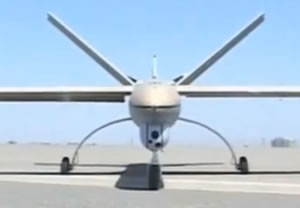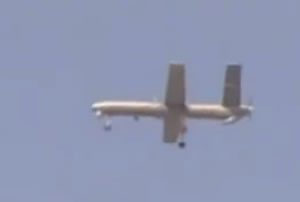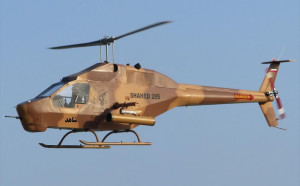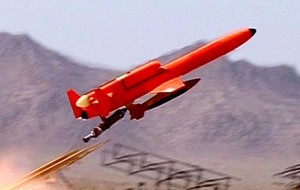

In recent weeks Iran has introduced new guided weapon systems claimed to be based on indigenous developments. Among these weapons are the Shahed 129 attack Unmanned Aerial Vehicle (UAV), precision guided version of the Zelzal medium range rocket, and Taer medium-range air-defense missile, positioned to be a precursor for the country’s new category of air defense weapon systems.
Major General Mohammad Ali Jafari, Commander of the Islamic Revolution Guards Corps introduced the Shahed 129 UAV in September 2012. Shahed 129 described as a ‘clone of the Israeli Hermes 450’ was developed by the corps’ military production facilities can carry can the Sadid guided missile it can carry.
[nonmember]Is the Iranian Shahed a reversed engineered hermes 450? If so, what are the implications for Israel’s UAV fleet? Sign up for Defense-Update Premium Account to know more…[/nonmember]
[ismember]While Shahed 129 looks very similar to the Israeli drone, or its UK ‘Watchkeeper’ version, it is not exactly a copy. Among the main differences visible in the video are the ‘shoulder wing’ configuration (similar to the Watchkeeper, but different from the Hermes 450 high wing). The primary EO/IR payload is located well forward of the center of Gravity (CG), below the nose, unlike the Hermes and Watchkeeper more centered placement. This added weight is likely be compensated by the V-tail, visibly having larger area. This configuration (also employed in the Turkish Anka), is clearing the airframe for heavier payload closer to the CG could indicate the vehicle is designed to carry heavier payloads – such as radar carried under the fuselage, bell-stored fuel or wing-loaded weapons.
The Shahed 129 has a mission endurance of 24 hours. Theoretically, Shahed 129 can fly out to a range of 1,700 km, however, lacking satellite link, it is practically limited to operate via remote control at a distance of about 150 km for 24 hour mission. Beyond that range, Shahed 129 can use its on-board autopilot to navigate a preplanned mission for the rest of the mission. Iranian military officials have said that Shahed 129 UAS can increase Iran’s surveillance capabilities in border areas, the Persian Gulf and the Sea of Oman. The Shahed 129 can carry Sadid-1 guided missiles. Shahed 129 has already been deployed with IRGC forces in the recent ‘Great Prophet 7’ exercise this summer.
The chances that Iran could have designed a UAV from scratch, that would be so similar to the Israeli drone are slim. More likely, Tehran managed to obtained the remains of Israeli Hermes 450 drones downed over Lebanon, (for technical reasons or hostile fire). By reverse engineering the air vehicle, the Iranians could have optimised the drone to be capable of missions similar to tose the Israelis originally developed this drone for in the mid 1990s. If this is the case, it is likely the Iranians have also gained access to the drone’s vehicle control systems, or communications links. In this case, the Israelis could expect Iranian attempts to challenge their systems using cyber attacks, which may explain the intriguing event over Israel on October 6, 2012 when a drone was shot down north of the city of Beersheba, after loitering for half an hour over the country.
[wzslider info=”true” lightbox=”true”][/ismember]
In 2010 Iran unveiled an optionally piloted helicopter designated Shahed 285 at the 4rd International Iran Kish Air Show. This helicopter was based on the larger Shahed 278 naval attack helicopter, which can carry up to eight Sadid-1 guided missiles. These missiles are similar in diameter and container size to the Israeli Spike LR missile.

The maximum takeoff weight of the Shahed 285 as reported by the Iranians, is 1.45 ton, based on an empty (dry) weight of 820 kg, leaving 630 kg for fuel, payload and potentially, a single crew member. The heli-drone has a maximum speed of 225 km/h and mission endurance of five hours, sustaining mission range of 875 km. The hover ceiling out of ground effect is 2,040 meters and service ceiling is 4,160 meters.

In 2010 Iran unveiled another unmanned aircraft capable of carrying weapons – the Karrar. Few months later, in February 2011, Iran inaugurated the production line of two other locally designed UAVs with bombing and reconnaissance capabilities. These two drones were named Raad (Thunder) and ‘Nazir’ (Harbinger). Both were designed to conduct long-range reconnaissance, patrolling, assault and bombing missions with high precision.
Iran Flexing Muscles: [nonmember](Subscriber version)[/nonmember]
- Part 1: Combat UAVs
- Part 2: a New ‘Stealth’ Frigate
- Part 3: Air Defense & Ballistic Missiles
















